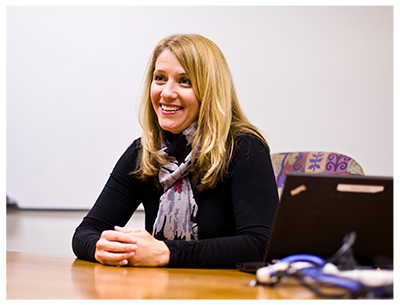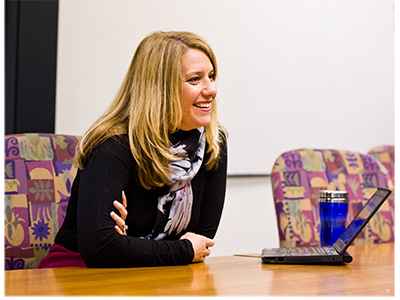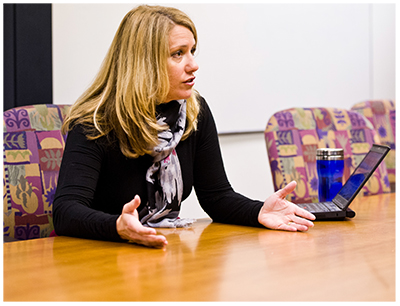The summer of 2011 might have been a chance for Diane Tavenner to rest on laurels, but the CEO of Summit Public Schools is not a restful sort of person.
The California Charter Schools Association had named Tavenner Charter Leader of the Year in 2010. Summit’s first charter high school, Summit Prep, launched in 2003, was featured in the film Waiting for Superman (2010). The 400-student school in Redwood City, California—midway between San Francisco and San Jose—was named one of the Top 10 Most Transformative Schools in the country by Newsweek in 2011.
 Summit’s second Redwood City high school, Everest, which opened in 2009, had strong test scores and a wait list. Summit was expanding to San Jose in response to parent demand so strong she was opening two new high schools there, Rainier and Tahoma, with 100 9th graders in each.
Summit’s second Redwood City high school, Everest, which opened in 2009, had strong test scores and a wait list. Summit was expanding to San Jose in response to parent demand so strong she was opening two new high schools there, Rainier and Tahoma, with 100 9th graders in each.
Dissatisfied, Tavenner decided it was time to radically rethink Summit’s teaching model. Summit partnered with Khan Academy, known for its online lessons and progress-tracking dashboard, to pilot “hybrid” math instruction at the new high schools. Students fill in knowledge gaps and develop math skills online, working at their own level and at their own pace, while also applying math to projects and learning from teachers. The goal is to create “self-directed learners.”
Fast-forward to 2013: Tavenner’s plans include a “Silicon Valley College Ready Corridor” with 14 high-performing, heterogeneous schools in the 50 miles from South San Francisco to San Jose. Two “next generation” schools will open in the fall: a high school in Daly City and a middle/high school in Sunnyvale.
The Summit Prep Model
With Summit Prep and Everest, “we took the factory model high school and did it significantly better,” Tavenner explains. “We made it smaller, more personal, with no tracking, longer hours, more support for kids. We recruited very talented teachers and fully developed them. But it’s still a factory model and kids are moving through that system.”
Summit hires graduates of elite universities to teach a college-prep curriculum that includes six Advanced Placement (AP) courses. About half the Redwood City students are Latino and black. Many come from Spanish-speaking families and start 9th grade with significant gaps in their academic skills and knowledge. Some take a basic skills class in addition to college-prep classes. They can take more time to pass if they need it, says Tavenner. “Algebra I ends when you show competency. It doesn’t necessarily end in June.”
The Redwood City schools also enroll students from white and Asian American families that range from middle class to wealthy. Some are top students who choose Summit for the rigor and the Ivy-educated faculty. Some have learning disabilities.
Students from all backgrounds like the small size—a maximum of 400 students—and the sense of community.
Nearly all graduates are accepted at four-year colleges and universities. The six-year college-graduation rate is expected to be 55 percent for Summit Prep’s first graduating class, nearly the same as the national average for all students. That isn’t good enough for Tavenner. Students who’ve relied on supportive high-school teachers may not be prepared to “drive their own learning” in college, she says. “We need to let kids set goals, make plans, maybe fail in lots of short cycles. Try, fail, learn.”
On a sunny Valentine’s Day in 2013, Tavenner, 41, sits in a room in the old elementary school that’s now the temporary site of Rainier and Tahoma. She has no office. She works in shared space at one of Summit’s two Redwood City schools or at the San Jose campus, which is nestled behind National Hispanic University’s newer buildings in a part of town with many immigrant families.
Valentine’s Day is her least favorite day to spend with hormonally excited 14- and 15-year-olds. Still, the drab campus is enlivened by teenagers carrying red and pink balloons and pink-frosted cupcakes. Half the students are on their way to classrooms, while the other half head for a large room where a more personalized learning environment has been created.
In the second year of the experiment, Summit has gone “beyond blended learning” to create what Tavenner calls an “optimized learning environment.”
Two hundred 9th and 10th graders at a time spend two hours a day studying math and brushing up on basic skills. They start at a work station by opening their personal guide, reading e-mail from the math teachers, and setting goals. Students can choose from a “playlist” of online learning resources, seek help at the “tutoring bar,” participate in teacher-led discussions in breakout rooms, or work on group projects, such as designing a water fountain.
When they’re ready, students take an online test to see if they’ve reached their goals. The math team, five teachers and two coaches, keeps students on track.
It’s an experiment in progress, but results are promising, says Tavenner. Next year, San Jose students will spend the whole day in self-directed learning.
Summit was started by affluent Silicon Valley parents in the Sequoia Union High School District, which includes some of the wealthiest towns in the U.S. (Atherton, Woodside, and Portola Valley), affluent Menlo Park, middle-class Belmont and San Carlos, blue-collar Redwood City, and low-income East Palo Alto. The high schools compete with excellent private schools.
Sequoia’s leaders and teachers bitterly opposed Summit, but a district in far-off Tuolumne County agreed to charter the new school for a small share of state funding.
From the start, Summit was accused of being an “elitist” school for wealthy whites who didn’t want their kids to mix with Latinos and blacks. The founding parents vowed to recruit students of all colors and income levels. They hired Tavenner, then vice principal of nearby Mountain View High School, to fulfill that promise.
A native of South Lake Tahoe, she earned a bachelor’s degree in psychology and sociology at the University of Southern California and a teaching credential at Loyola Marymount University. After five years of teaching English and journalism at “a classic inner-city dropout factory” near Los Angeles, she was so frustrated that she considered leaving teaching.
By then, she’d married Scott Tavenner, whom she first met when they were 15-year-olds at a summer leadership camp at Stanford. He persuaded her to try teaching at a different sort of school. The couple moved to Mountain View in the heart of Silicon Valley. While he ran an online advertising business, she taught English at Mountain View High, which was trying to close a large achievement gap between its affluent white and Asian American students and its working-class Mexican American minority. Tavenner was intrigued by the school’s decision to open AP classes to all students.
After earning a master’s degree in educational administration and policy analysis at Stanford, Tavenner moved into administration.
Opening up AP wasn’t enough to close the gaps, she realized. “How do we get students to make good choices? How do we inform parents? How do we teach? How do we organize courses?”
She liked the work, but didn’t think the high school would go as far as she wanted. Then she heard about the Summit job, “a chance to start from scratch” with a school that would educate all kids together.
“When you live in Silicon Valley, there’s so much entrepreneurship, it’s hard to resist,” she says.
A new mother at the time—her son is now 10—Tavenner set out to create a new charter school. She went to elementary and middle schools, libraries, and lots of churches in Redwood City to spread the word. She asked new recruits to reach out to their friends. “Every one of those first families I had a relationship with,” she recalls.
Forging a unified school community was a challenge. The school almost started with two parent groups, one for English speakers and one for Spanish speakers. To Tavenner’s relief, parents decided on one group with co-presidents from each community. Meetings are conducted in both languages.
Teaching in a “truly heterogeneous environment is really hard to do and generally not done well,” Tavenner says. It’s always been her goal.
“I want to have as many doors open as possible, including being legitimately ready for success in a four-year college when they graduate. I don’t think our education system does that.”
Although Summit’s enrollment reflected the district’s demographics, the school was accused of creaming the best students. “I took it very personally,” Tavenner says. Dealing with Sequoia was “the hardest thing I’ve ever had to do.”
Battling for Everest
Sequoia took over Summit Prep’s charter in 2006, but the school board denied a charter to Everest.
“Everest is clearly not designed for low-performing students, and in fact Everest focuses selectively on high-achieving, privileged students,” charged Sequoia superintendent Pat Gemma, in a 2008 newspaper commentary. “Everest proposes offering a solely college preparatory curriculum to prepare all its students for enrollment in a four-year college.”
“The superintendent said kids of color won’t want this because it’s college prep,” Tavenner recalls, still fuming. “Teachers said we were an elitist school. It made me become a mama bear. It was a fight, a war zone.”
Summit was “demonstrably unlikely to successfully implement” Everest’s financial plan, concluded district staff. Summit Prep had demonstrably succeeded with the same plan, Tavenner pointed out, in vain. The charter network raises donations to fund start-up costs. When fully enrolled, schools operate on the same state funding as other high schools.
Sequoia trustees also claimed a new charter would draw white students away from two small charter high schools serving East Palo Alto that enrolled blacks, Latinos, and Pacific Islanders, but no whites.
After the state board of education chartered Everest, Sequoia offered a vacant lot in East Palo Alto. Summit filed a lawsuit to force the district to provide facilities, as required by state law. When Sequoia named a new superintendent in 2010, the fighting ended. The charter school now has a “very good” relationship with the district, Tavenner says.
Taming the Wild West
In Summit’s early years, “some people thought charter schools could be ‘stamped out,’” Tavenner says. “It was the Wild, Wild West.”
Now 8 percent of California’s public school students attend the more than 1,000 charter schools statewide. As president of the member council of the California Charter Schools Association, Tavenner believes strongly that ineffective schools should be closed. “It can’t be like traditional schools that perpetually fail,” she says.
But it’s clear that charters are here to stay. And so is Summit.
Hewlett-Packard CEO Meg Whitman, who serves on the board of Summit Public Schools, donated $2.5 million to fund new schools and pledged to match up to $2.5 million in contributions from other high-tech leaders, potentially giving Summit $7.5 million for the Silicon Valley corridor. Attracting high-profile supporters is undoubtedly aided by a strong track record: all four Summit charters exceed state goals on the Academic Performance Index. Summit also has raised an innovation fund to pay for its experiments with “optimized” learning.
While it’s easier to start a charter school than it was 10 years ago, it takes a “solid plan” and “a leadership team with experience in running schools and running a business,” advises Tavenner. “It’s a political process. Do your homework, meet with everyone, be open to feedback.” And perform.
Joanne Jacobs, a former San Jose Mercury News editorial writer and columnist, writes about K–12 education and community colleges at joannejacobs.com and ccspotlight.org. She’s the author of Our School on the early years of a San Jose charter school that prepares Mexican American students for college.
This article appeared in the Summer 2013 issue of Education Next. Suggested citation format:
Jacobs, J. (2013). Learning Optimized: A conversation with Diane Tavenner. Education Next, 13(3), 44-47.





